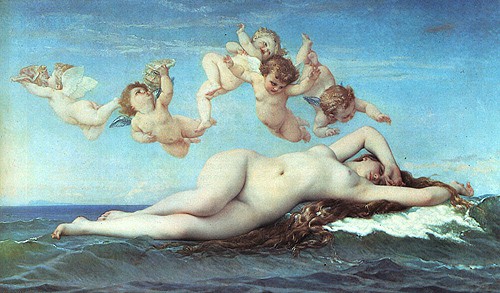In May 1863, the whole of Paris rushed to the Salon des Refusés, which had been commissioned by the Emperor Napoleon III in response to the many complaints received from artists whose works had be rejected by the jury of the official Salon. One particular work caused a huge scandal, Manet's Le Bain – subsequently renamed Le Déjeuner sur l'herbe -, which attracted the opprobrium of critics and sarcastic remarks from the gallery. This country scene in which a naked woman was sitting between two clothed men, whilst another woman in shift could be in seen the background, made the public indignant. At the official Salon, another female nude was however received in triumph – it was Alexandre Cabanel's La Naissance de Vénus (The Birth of Venus). Here a voluptuous goddess can be seen emerging from the waves in a lascivious and inviting pose, which would seem today to be much more licentious than the women in Le Déjeuner sur l'herbe. Manet's crime in fact was to have painted real bodies in a contemporary setting, thereby transgressing the rules of academic paintings and furthermore scandalising contemporary morals. The scandal was to reach its height in the Salon of 1865 with Manet's great realist and provocative nude, Olympia.
During the Second Empire, there was a renewal of the 'nude' genre, beginning in the 1860s. The Ecole des Beaux-Arts, where Cabanel himself was a teacher, made nude study from life an important stage in the training. The female nude was however only allowed when covered by a mythological, allegorical or orientalist 'pretext'. The walls of the Salons could therefore be literally covered with the idealised bodies of goddesses and odalisques without the slightest deleterious effect upon public morals. Unreal and suave, Cabanel's Vénus is the perfect embodiement of the official taste of imperial society, for which Théophile Gauthier in the newspaper, the Moniteur Universel, made himself as spokesman: “The girl from the waves is soon to become a woman. It is impossible to imagine anything fresher, younger, prettier, than that head laid back on the bending arm. It is the ideal of childlike, charming grace”. The general appreciation in the work was such that Napoleon III himself bought the work through the civil list. In 1867, the Emperor had the painting displayed once again at the Universal Exhibition. A fact which led Zola, great supporter of Manet, to write this perspicacious critique: “Take an antique venus, the body of any woman whatsoever drawn according to the sacred rules, and, lightly, with a powder puff, dab colour and powder on the body; there you have Monsieur Cabanel's ideal […] This goddess, drowned in a sea of milk, looks like a delicious dance-hall girl, but not of flesh and blood – that would be indecent – but made of a sort of pink and white marzipan”.
Karine Huguenaud (tr. P.H.)
October 2003
The Birth of Venus
Artist(s) : CABANEL Alexandre


